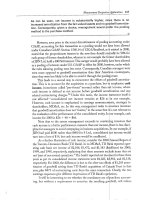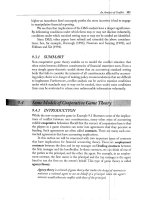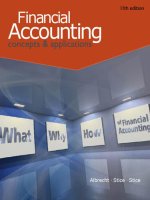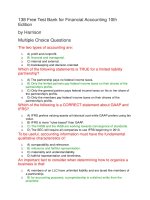Financial accounting 10th by harmin ch11
Bạn đang xem bản rút gọn của tài liệu. Xem và tải ngay bản đầy đủ của tài liệu tại đây (4.07 MB, 107 trang )
Prepared by
Coby Harmon
University of California, Santa Barbara
Westmont College
11-1
11
Corporations: Organization, Stock Transactions, and
Stockholders’ Equity
Learning Objectives
11-2
1
Discuss the major characteristics of a corporation.
2
Explain how to account for the issuance of common, preferred, and treasury stock.
3
Explain how to account for cash dividends, stock dividends, and stock splits.
4
Discuss how stockholders’ equity is reported and analyzed.
LEARNING
1
OBJECTIVE
Discuss the major characteristics of a corporation.
An entity separate and distinct from its owners.
Classified by Purpose
11-3
Classified by Ownership
Not-for-Profit
Publicly held
For Profit
Privately held
►
Salvation Army
►
McDonald’s
►
American Cancer Society
►
Nike
►
Cargill Inc.
Alternative
Alternative Terminology
Terminology
►
PepsiCo
►
Privately
Privately held
held corporations
corporations
are
are also
alsoreferred
referred to
to as
as
closely
closely held
held corporations.
corporations.
LO 1
Characteristics of a Corporation
Characteristics that distinguish corporations from proprietorships and partnerships.
11-4
Separate Legal Existence
Limited Liability of Stockholders
Transferable Ownership Rights
Advantages
Ability to Acquire Capital
Continuous Life
Corporate Management
Government Regulations
Additional Taxes
Disadvantages
LO 1
Characteristics of a Corporation
Characteristics that distinguish corporations from proprietorships and partnerships.
Corporation acts under its own name
11-5
Separate Legal Existence
rather than in the name of its
Limited Liability of Stockholders
stockholders.
Transferable Ownership Rights
Ability to Acquire Capital
Continuous Life
Corporate Management
Government Regulations
Additional Taxes
LO 1
Characteristics of a Corporation
Characteristics that distinguish corporations from proprietorships and partnerships.
11-6
Separate Legal Existence
Limited Liability of Stockholders
Transferable Ownership Rights
Ability to Acquire Capital
Continuous Life
Corporate Management
Government Regulations
Additional Taxes
Limited to their investment.
LO 1
Characteristics of a Corporation
Characteristics that distinguish corporations from proprietorships and partnerships.
11-7
Separate Legal Existence
Limited Liability of Stockholders
Transferable Ownership Rights
Ability to Acquire Capital
Continuous Life
Corporate Management
Government Regulations
Additional Taxes
Shareholders may sell their stock.
LO 1
Characteristics of a Corporation
Characteristics that distinguish corporations from proprietorships and partnerships.
11-8
Separate Legal Existence
Limited Liability of Stockholders
Transferable Ownership Rights
Corporation can obtain capital
Ability to Acquire Capital
through the issuance of stock.
Continuous Life
Corporate Management
Government Regulations
Additional Taxes
LO 1
Characteristics of a Corporation
Characteristics that distinguish corporations from proprietorships and partnerships.
11-9
Separate Legal Existence
Limited Liability of Stockholders
Transferable Ownership Rights
Continuance as a going concern is
Ability to Acquire Capital
not affected by the withdrawal,
death, or incapacity of a stockholder,
Continuous Life
Corporate Management
Government Regulations
Additional Taxes
employee, or officer.
LO 1
Characteristics of a Corporation
Characteristics that distinguish corporations from proprietorships and
partnerships.
11-10
Separate Legal Existence
Limited Liability of Stockholders
Transferable Ownership Rights
Ability to Acquire Capital
Continuous Life
Corporate Management
Government Regulations
Additional Taxes
Separation of ownership and
management often reduces an
owner’s ability to actively manage
the company.
LO 1
Characteristics of a Corporation
Characteristics that distinguish corporations from proprietorships and partnerships.
11-11
Separate Legal Existence
Limited Liability of Stockholders
Transferable Ownership Rights
Ability to Acquire Capital
Continuous Life
Corporate Management
Government Regulations
Additional Taxes
LO 1
Characteristics of a Corporation
Characteristics that distinguish corporations from proprietorships and partnerships.
Separate Legal Existence
Limited Liability of Stockholders
Transferable Ownership Rights
Ability to Acquire Capital
11-12
Continuous Life
Corporate Management
Government Regulations
Additional Taxes
Corporations pay income taxes as a
separate legal entity and in addition,
stockholders pay taxes on cash
dividends.
LO 1
Characteristics of a Corporation
Stockholders
Illustration 11-1
Corporation organization chart
Chairman and
Board of
Directors
President and
Chief Executive
Officer
General
Counsel/
Secretary
Vice President
Marketing
Treasurer
11-13
Vice President
Finance/Chief
Financial Officer
Vice President
Operations
Vice President
Human
Resources
Controller
LO 1
Forming a Corporation
Initial Steps:
File application with the Secretary of State.
State grants charter.
Corporation develops by-laws.
Companies generally incorporate in a state whose laws are favorable to the corporate form of business
(Delaware, New Jersey).
Corporations engaged in interstate commerce must obtain a license from each state in which they do
business.
11-14
LO 1
Stockholder Rights
1.
Vote in election of board of directors and on actions that
require stockholder approval.
2.
Share the corporate earnings through receipt of dividends.
Illustration 11-3
Ownership rights of
stockholders
11-15
LO 1
Stockholder Rights
3.
Keep the same percentage ownership when new shares of stock are issued (preemptive right).
* A number of companies have eliminated the preemptive right.
Illustration 11-3
Ownership rights of
stockholders
11-16
LO 1
Stockholder Rights
4.
Share in assets upon liquidation in proportion to their holdings. This is called a residual claim.
Illustration 11-3
Ownership rights of
stockholders
11-17
LO 1
Stock Issue Considerations
When a corporation decides to issue stock, it must resolve a number of basic questions:
11-18
1.
How many shares should it authorize for sale?
2.
How should it issue the stock?
3.
What value should the corporation assign to the stock?
LO 1
Stock Issue Considerations
AUTHORIZED STOCK
11-19
Charter indicates the amount of stock that a corporation is authorized to sell.
Number of authorized shares is often reported in the stockholders’ equity section.
No formal accounting entry.
LO 1
Stock Issue Considerations
Prenumbered
Shares
Illustration 11-4
Name of corporation
Stockholder’s name
Signature of corporate official
11-20
LO 1
Stock Issue Considerations
ISSUANCE OF STOCK
Companies issue common stock directly to investors or indirectly through an investment banking
firm.
11-21
Factors in setting price for a new issue of stock:
1.
Company’s anticipated future earnings.
2.
Expected dividend rate per share.
3.
Current financial position.
4.
Current state of the economy.
5.
Current state of the securities market.
LO 1
Stock Issue Considerations
MARKET PRICE OF STOCK
11-22
Stock of publicly held companies is traded on organized exchanges.
Interaction between buyers and sellers determines the prices per share.
Prices tend to follow the trend of a company’s earnings and dividends.
Factors beyond a company’s control may cause day-to-day fluctuations in market prices.
LO 1
ANATOMY OF A FRAUD
The president, chief operating officer, and chief financial officer of SafeNet, a software encryption company, were each awarded employee stock
options by the company’s board of directors as part of their compensation package. Stock options enable an employee to buy a company’s stock
sometime in the future at the price that existed when the stock option was awarded. For example, suppose that you received stock options today,
when the stock price of your company was $30. Three years later, if the stock price rose to $100, you could “exercise” your options and buy the
stock for $30 per share, thereby making $70 per share. After being awarded their stock options, the three employees changed the award dates in
the company’s records to dates in the past, when the company’s stock was trading at historical lows. For example, using the previous example, they
would choose a past date when the stock was selling for $10 per share, rather than the $30 price on the actual award date. In our example, this
would increase the profit from exercising the options to $90 per share.
Total take: $1.7 million
THE MISSING CONTROL
Independent internal verification. The company’s board of directors should have ensured that the awards were properly administered. For
example, the date on the minutes from the board meeting should be compared to the dates that were recorded for the awards. The dates should
again be confirmed upon exercise.
11-23
LO 1
Stock Issue Considerations
PAR AND NO-PAR VALUE STOCK
Years ago, par value determined the legal capital per share that a company must retain in the
business for the protection of corporate creditors.
11-24
Today many states do not require a par value.
No-par value stock is fairly common today.
In many states, the board of directors assigns a stated value to no-par shares.
LO 1
Stock Issue Considerations
Question
Which of these statements is false?
11-25
a.
Ownership of common stock gives the owner a voting right.
b.
The stockholders’ equity section begins with paid-in capital.
c.
The authorization of capital stock does not result in a formal accounting entry.
d.
Legal capital is intended to protect stockholders.
LO 1









